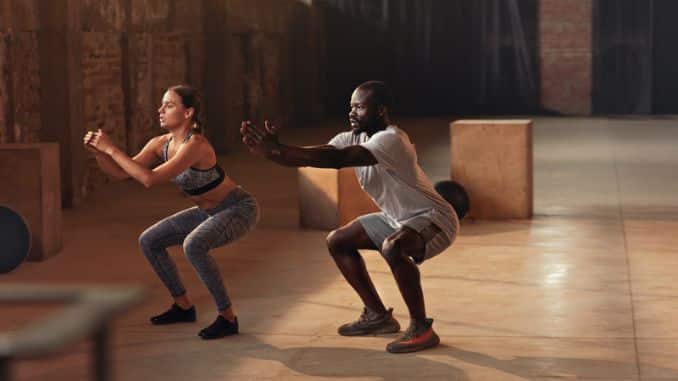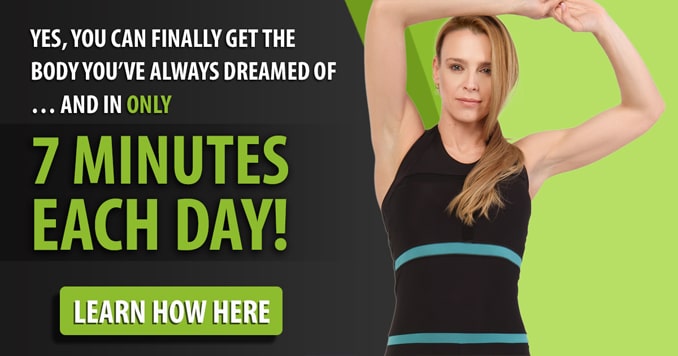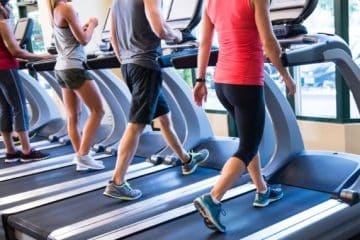A full-body blast workout is a high-intensity exercise routine that targets multiple groups simultaneously. This full-body workout plan aims to burn as many calories as possible while toning and strengthening the entire body.
These workouts typically involve resistance training and cardio exercises. With a focus on total body conditioning, this workout targets every muscle group and keeps you engaged from start to finish.
Full-body blast workouts are also perfect for those who are short on time but still want a complete workout. And great for those who want to take their fitness to the next level and challenge themselves.
So say goodbye to boredom and hello to a fitter, healthier you with this full-body workout!
How to Do Full Body Workout
When it comes to fitness, a full-body body workout is a great way to achieve overall fitness and strength. And a well-organized body workout plan can help you do these.
To do a full-body workout, start with a dynamic warm-up with stretching and movement exercises. This can include light cardio exercises like jumping jacks or jogging to get the blood flowing and the muscles warmed up. Once you have warmed up, you can move on to the main exercises.
Next, choose a combination of exercises that target all major muscle groups—the upper body, core, and lower body muscles. It's important to vary the exercises and range of repetitions to keep the workout challenging and prevent plateaus. It is also important to gradually increase the intensity of your body workout programs over time to avoid injury and achieve better results.
Some exercises for the best full-body workout include squats, lunges, push-ups, pull-ups, leg curls, and planks. These exercises can be modified to suit your fitness level.
It is also important to include cardio exercises in your full-body workout routine. This can include exercises like running, cycling, or swimming to help improve cardiovascular health and burn additional calories.
Additionally, incorporate compound exercises that work multiple muscle groups using the same exercises simultaneously for maximum effectiveness. Circuit training, or HIIT, is an example of this.
As with any workout, proper form and technique are key to preventing injury and maximizing results. Following a full-body workout plan ensures that you're targeting all areas of your body and progressing toward your fitness goals.
Choose the Right Exercises
Choosing the right exercises for full-body workouts is important. When selecting the right exercises for your fitness level, consider workouts that are age-appropriate, if relevant, depending on your settings.
Since your body's capabilities and limitations change as you age, avoiding exercises that could cause injury or strain is crucial.
This training program must include upper-body exercises for the upper chest and back, shoulders, and arms; lower-body exercises for the legs and glutes; and core exercises to strengthen the abdominals and lower back.
For upper-body exercises, options include push-ups, pull-ups, and shoulder presses. Squats, lunges, and deadlifts are great choices for lower-body exercises. Core exercises can include planks, crunches, and bicycles. Choosing the right exercises can be intimidating, but with a little guidance, anyone can create an effective and enjoyable training program.
Full Body Workout Basics
A Full Body Workout Program helps keep your body in shape and healthy. When designing a Full Body Workout Program, there are a few basics to remember.
First, include full-body workouts per training session targeting each major muscle group. This can be achieved through a combination of compound exercises and isolation exercises.
Another important aspect of a Full Body Workout Program is proper progression. This means gradually increasing your workouts' intensity, training frequency, and difficulty over time. This can be achieved by increasing the weight, reps, or sets of your exercises or incorporating more challenging exercises into your routine.
Follow these basics and feel great both inside and out.
A. Warm-Up Stretches
Warm-up stretches are an essential part of any physical activity. These exercises reduce the risk of injury.
1. Shoulder Rolls
Begin in an upright standing position with your feet shoulder-width apart, maintaining good alignment with your head, shoulders, hips, and legs. Engage your core. Lift your shoulders, then roll them down and back until you feel resistance in your shoulder blades. Lower your shoulders to the starting position, relax, and repeat the movement. Complete 10 repetitions.
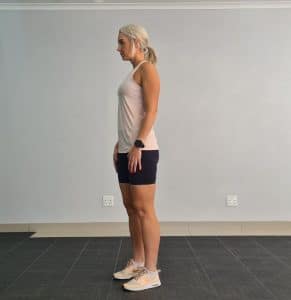 |
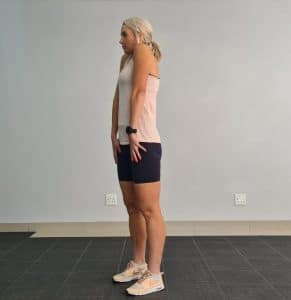 |
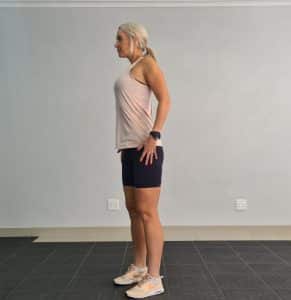 |
Shoulder Rolls
2. Arm Raises
Begin in an upright standing position with your feet shoulder-width apart, maintaining good alignment with your head, shoulders, hips, and legs. Engage your core and raise both arms overhead. Lower your arms to the starting position and repeat the movement. Start with 1 set of 5 repetitions.
 |
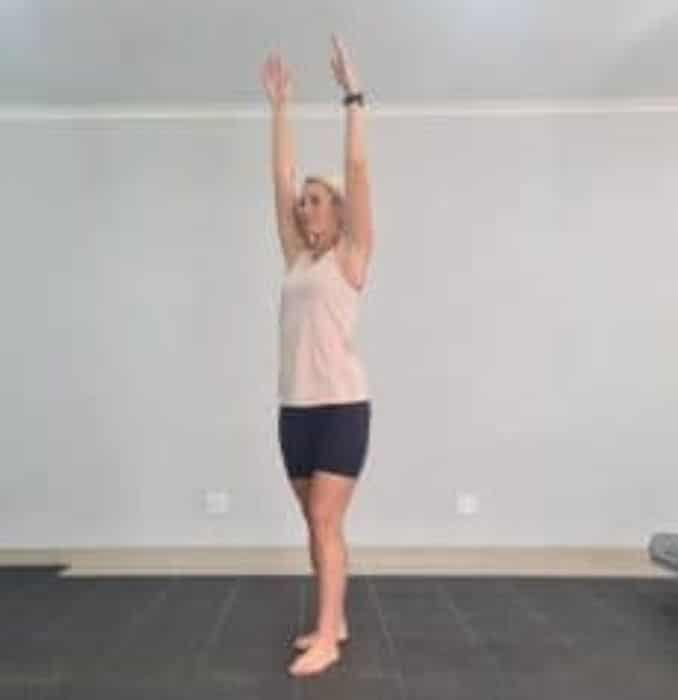 |
Arm Raises
3. Standing Twist
Begin in an upright standing position with your feet wider than shoulder-width apart, maintaining good alignment with your head, shoulders, and hips. Straighten your arms in front of your body and clasp your hands together at chest height. Engage your core and rotate your upper body to one side, opening one arm out as you keep your hips forward. Return to the starting position and repeat the movement on the opposite side. Start with 10 repetitions in each direction.
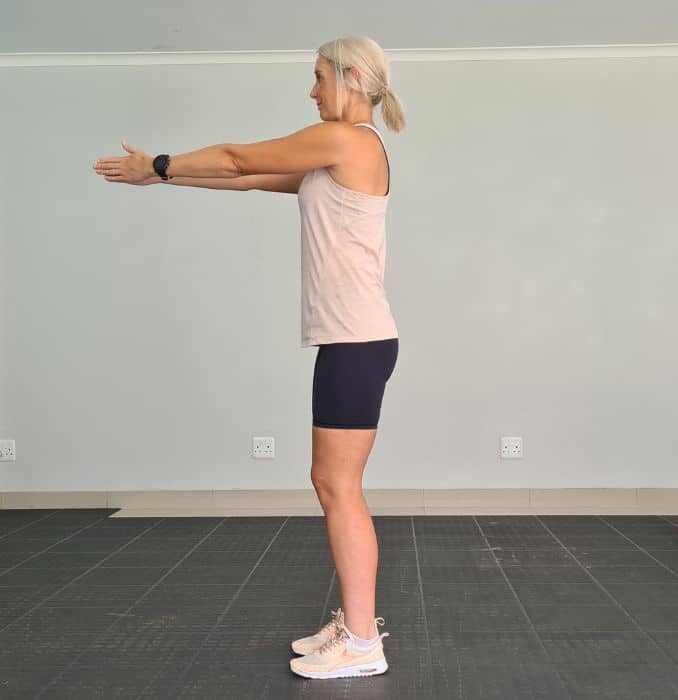 |
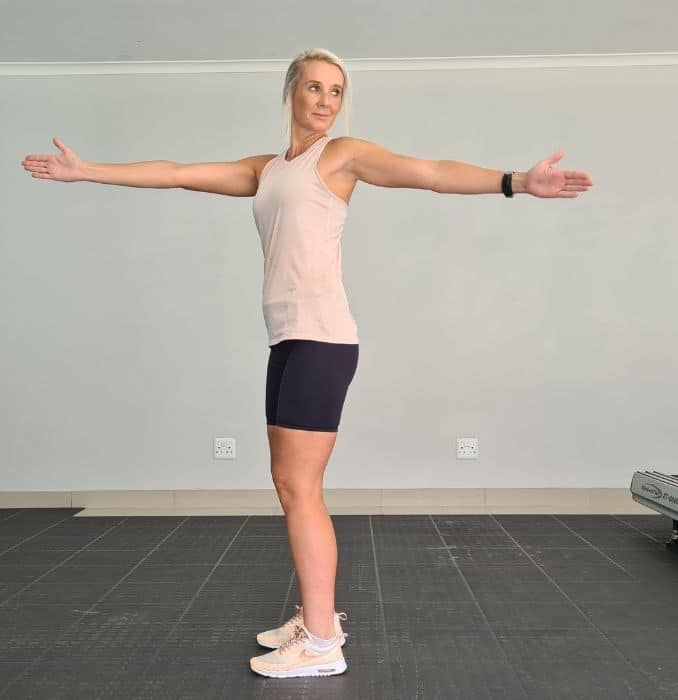 |
Standing Twist
4. Squats
Begin in an upright standing position with your feet wider than shoulder-width apart, maintaining good alignment with your head, shoulders, and hips. Tighten your abdominal muscles. Bend your knees and hinge through your hips to move into a squat position. Keep your knees behind your toes. Raise back to an upright standing position, squeezing your glutes at the top. Repeat the movement.
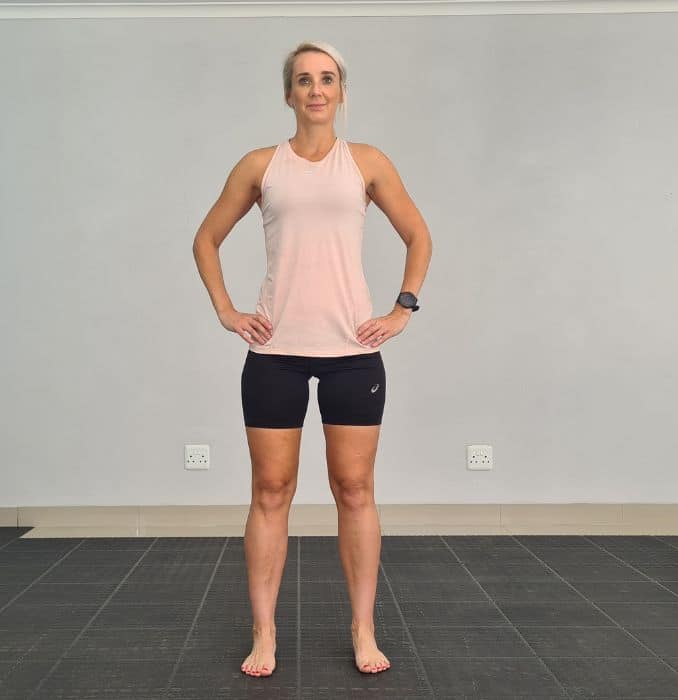 |
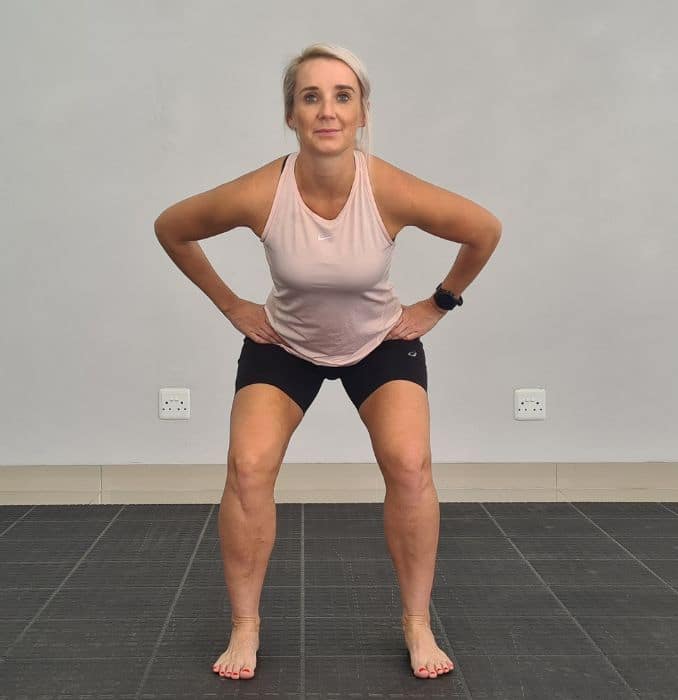 |
Low Squats
5. Side Stretches
Begin in an upright standing position with your feet shoulder-width apart, maintaining good alignment with the head, shoulders, and hips. Place your hands on your hips or upper thighs. Take a big step to the side with one foot and bend your leading knee to shift your weight while extending your opposite leg. Repeat the movement on the opposite side. Complete 10 repetitions on each side.
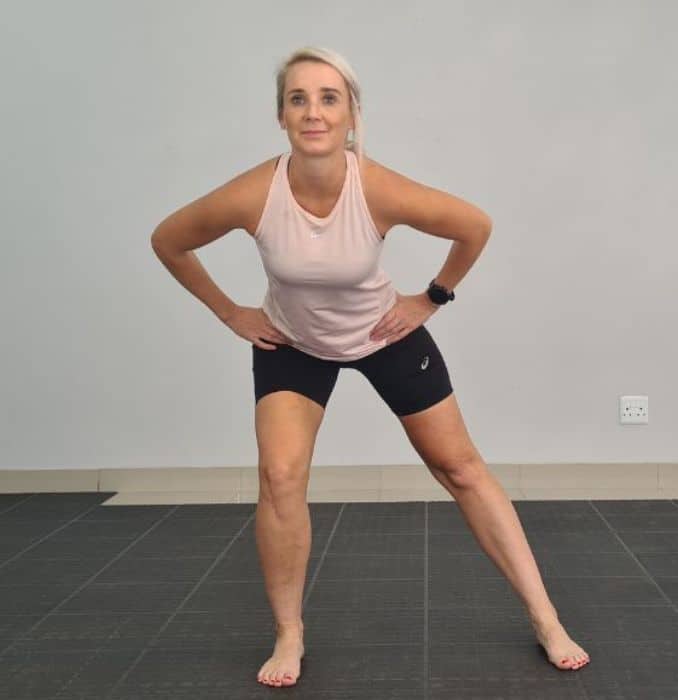 |
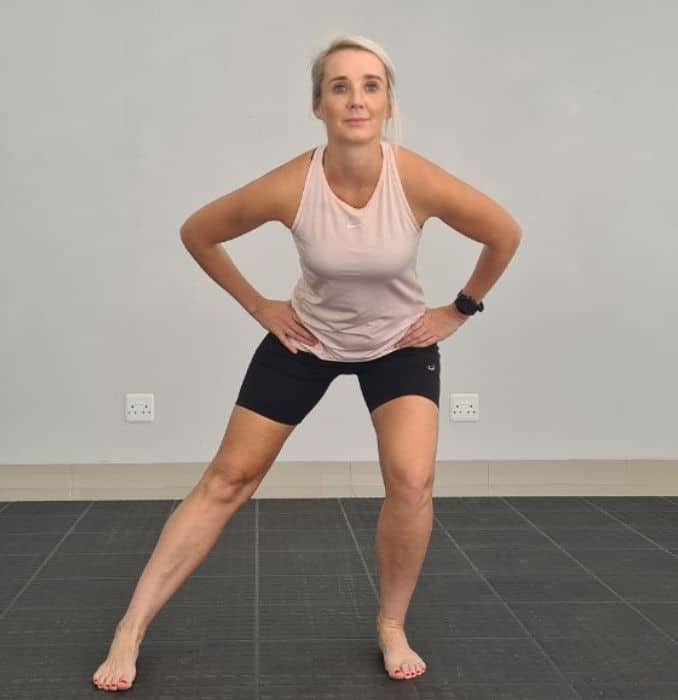 |
Lateral Lunges
B. Routine
Whether you're a beginner or a seasoned athlete, full-body workout routines can help you maintain a healthy, active lifestyle.
And including details about managing these exercises' frequency, intensity, and duration is important to maximize their benefits.
1. Inclined Push-Ups
Start in an upright standing position in front of a countertop, bench, or chair. Place your hands on the countertop and step back to move into a straight arm plank position, maintaining good alignment with your head, shoulders, hips, and toes. Contract your abdominal muscles. Bend your arms to lower your upper body, then straighten your arms to complete a push-up. Repeat the movement.
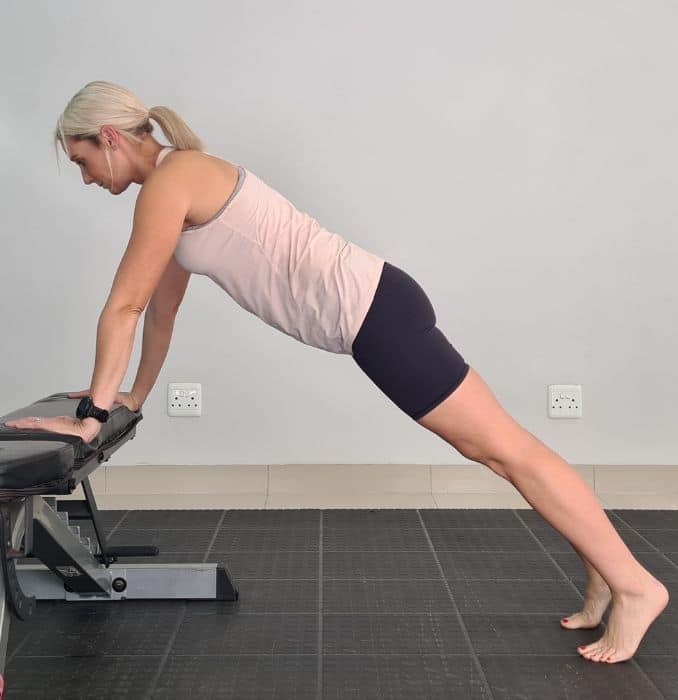 |
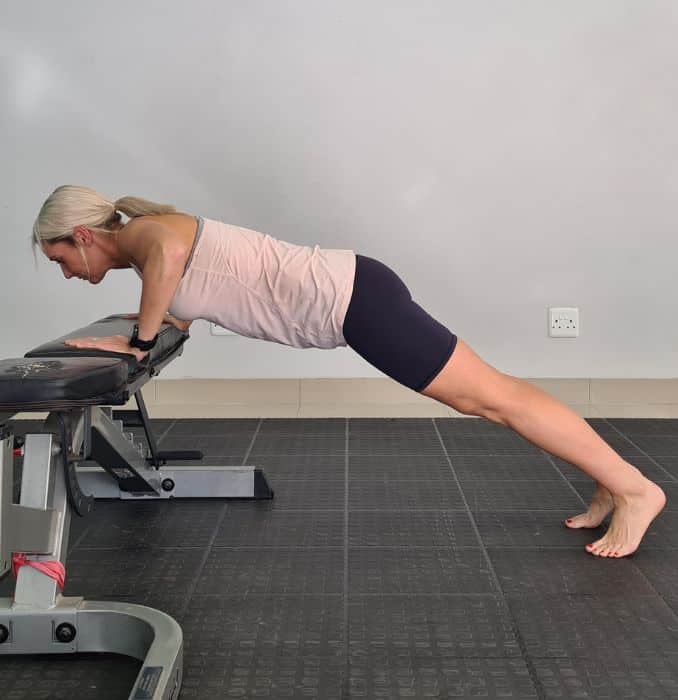 |
Inclined Push-Ups
2. Squat to Knee Drive
Begin in an upright standing position with your feet slightly wider than shoulder-width apart, maintaining good alignment with your head, shoulders, and hips. Engage your core. Bend your knees and hinge through your hips to lower your seat into a squat position, keeping your knees behind your toes. Raise back to an upright standing position, then drive one knee up to hip height as you lower your opposite elbow towards your bent knee. Lower your leg to the starting position and repeat the sequence of movements on the opposite side. Complete 10 repetitions, alternating sides.
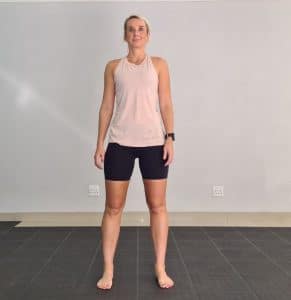 |
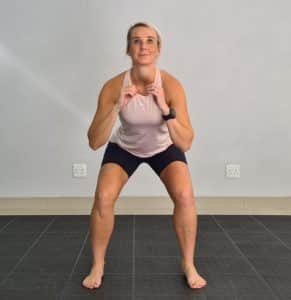 |
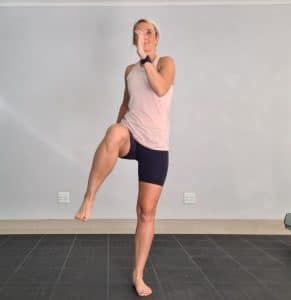 |
Squat to Knee Drive
3. I.Y.T
Begin in an upright standing position with your legs shoulder-width apart, maintaining good alignment with your head, shoulders, hips, and legs. Engage your core and hinge through your hips to move into an athletic position. Bring your arms down with your palms pressed together, then extend your arms overhead in an “I” position. Lower your arms down and lift your arms up wider than your shoulders into a “Y” position. Lower your arms down again and lift to open your arms out to the sides to form a “T position. Return to the starting position and repeat the sequence of movements for 10 repetitions.
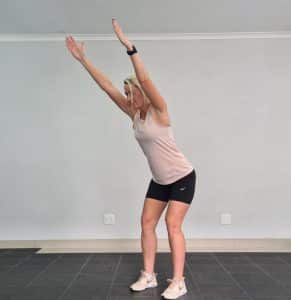 |
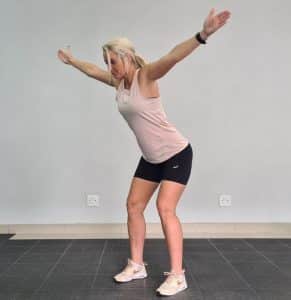 |
 |
I.Y.T
4. Lunge
Begin in an upright standing position with your hands on your hips, maintaining good alignment in your upper body. Engage your core. Take a big step back with one foot, then lower your back knee towards the ground, bending your front knee. Raise back up to the starting position and repeat the movement on the opposite side. Complete 10 repetitions on each side.
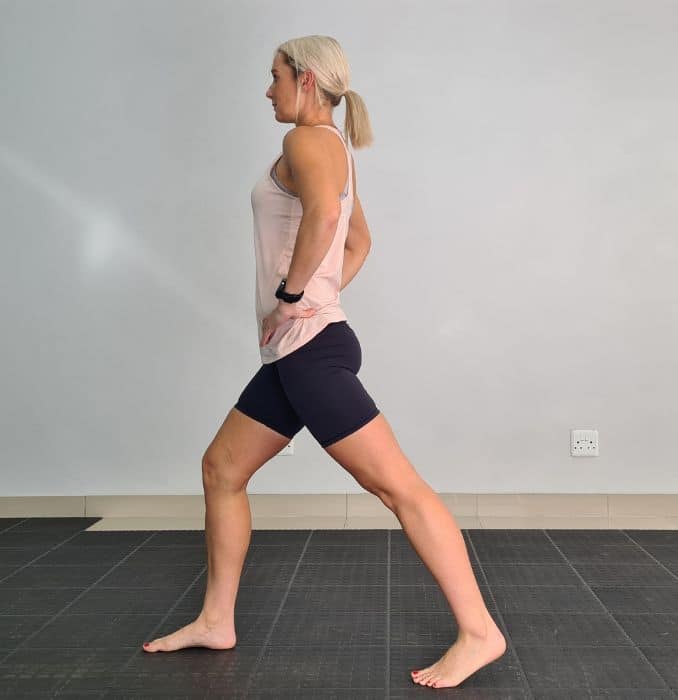 |
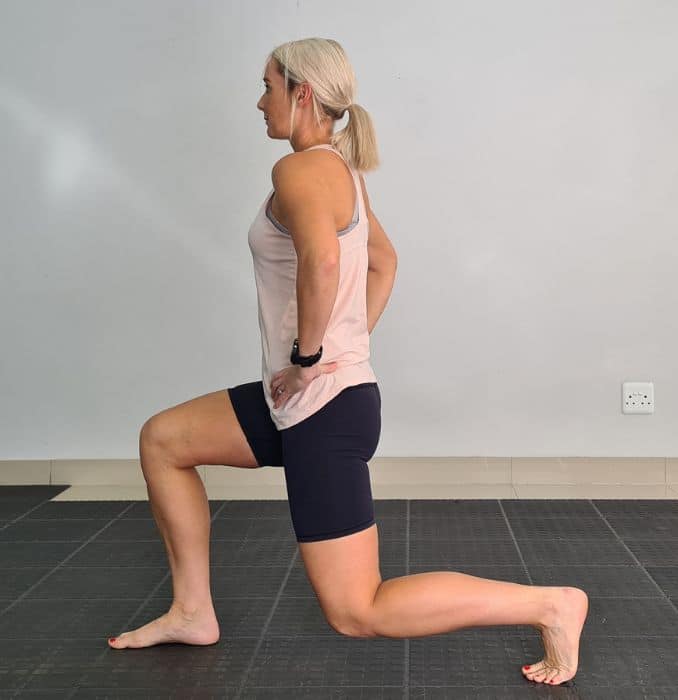 |
Lunge
5. Tricep Dips
Begin in an upright sitting position on the edge of a chair, with your feet flat on the floor, maintaining good alignment with your head, shoulders, and hips. Bring your hands at your sides on the chair. Engage your core and lift your seat off the chair with your thighs parallel to the floor. Slowly dip your hips toward the floor with your elbows bent at a 90-degree angle. Using your arms, lift back up to the starting position and repeat the movement. Complete 10 repetitions.
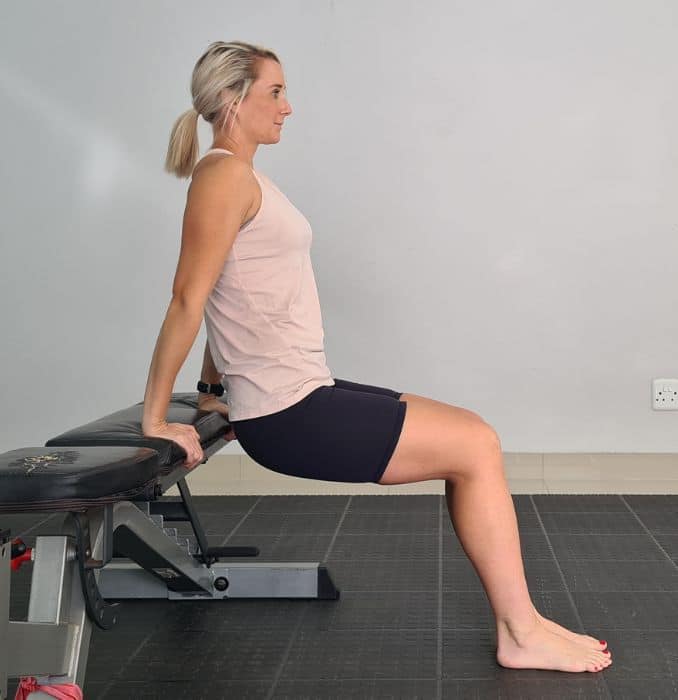 |
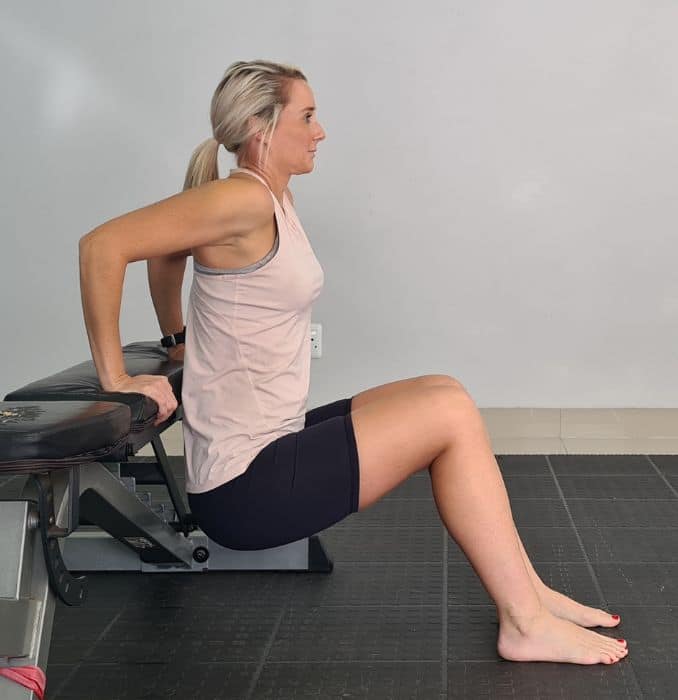 |
Triceps Dip
6. Mountain Climbers
Start in an upright standing position in front of a countertop, bench, or chair. Place your hands on the countertop and step back to move into a straight arm plank position, maintaining good alignment with your head, shoulders, hips, and toes. Contract your abdominal muscles, then drive one knee towards your chest. Return to the starting position and repeat the movement on the opposite leg. Complete 10 repetitions.
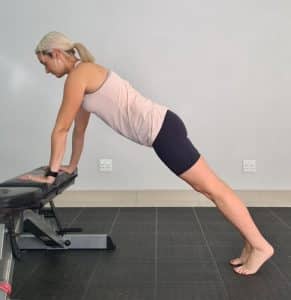 |
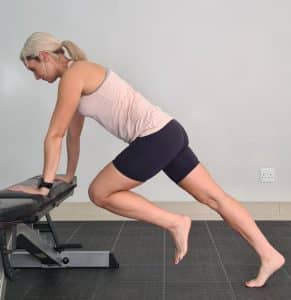 |
 |
Mountain Climbers
7. Side Lunge
Begin in an upright standing position with your feet wider than shoulder-width apart, maintaining good alignment in your upper body. Contract your abdominal muscles. Bend your knee and hinge through your hips to lower yourself into a side lunge while extending your opposite leg. Raise back up to return to the starting position and repeat the movement. After several repetitions, repeat the movement on the opposite side. Complete 10 repetitions on each side.
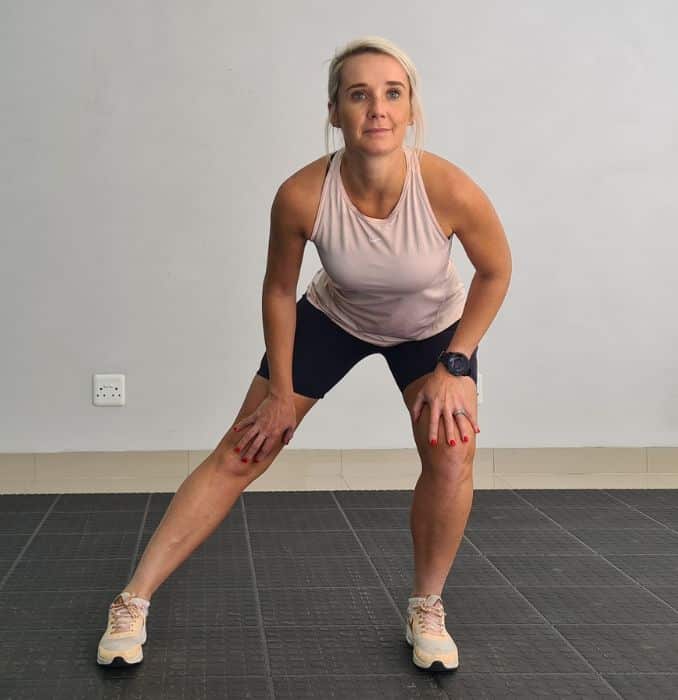 |
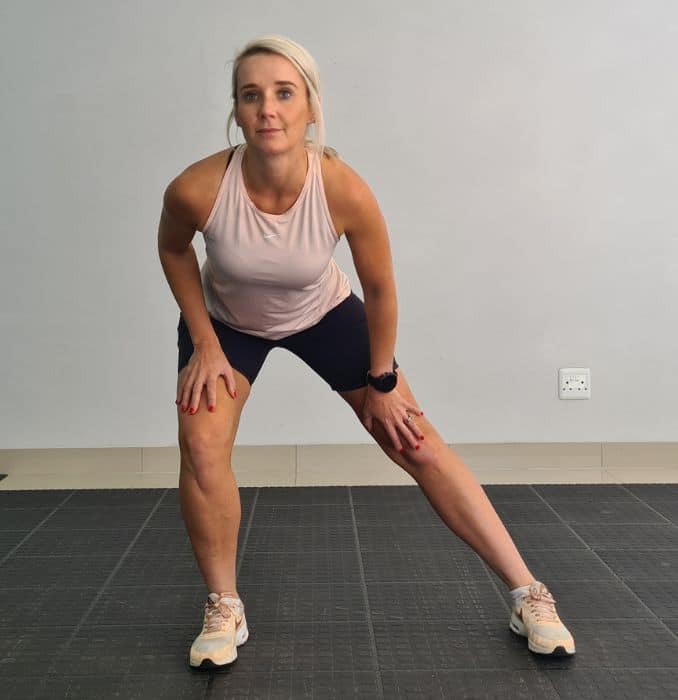 |
Side Stretches
C. Cool Down Stretches
Cool-down stretches are an essential part of any post-exercise routine.
Cooling down should be done for at least 5–10 minutes and performed moderately. Incorporating these stretches into your post-workout routine will help ensure that your body recovers properly and remains injury-free.
1. Cat-Cow
Begin in an upright standing position with your feet hip-width apart, maintaining good alignment with your head, shoulders, hips, and legs. Engage your core and hinge through your hips to move your upper body forward. Engage your core and place your hands on your knees. Slowly round your mid-back as you lower your head down. Alternate by lifting your head and arching your mid-back. Repeat the movement in alternating directions.
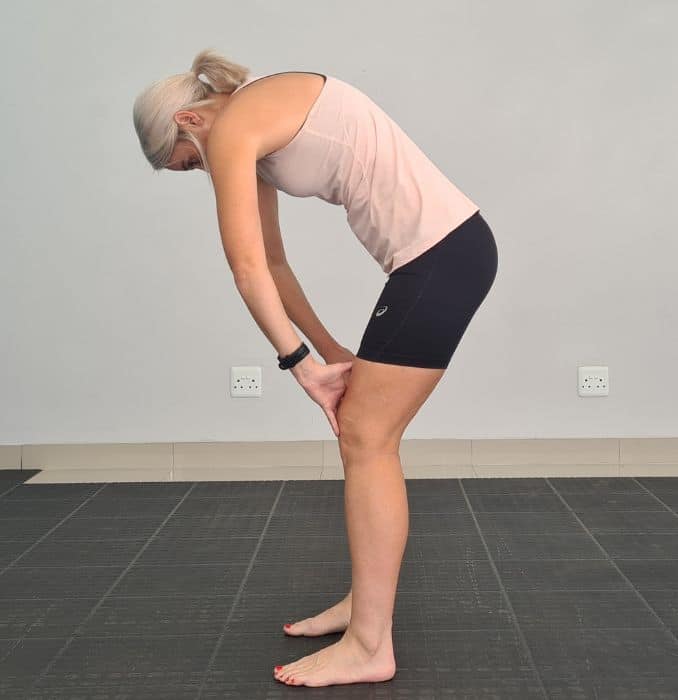 |
 |
Cat-Cow
2. Side Bend
Begin in an upright standing position with your feet slightly wider than shoulder-width apart, maintaining good alignment with your head, shoulders, and hips. Stretch your hands upward. Engage your core and bend your upper body to the side. Return to the starting position and repeat the movement on the opposite side.
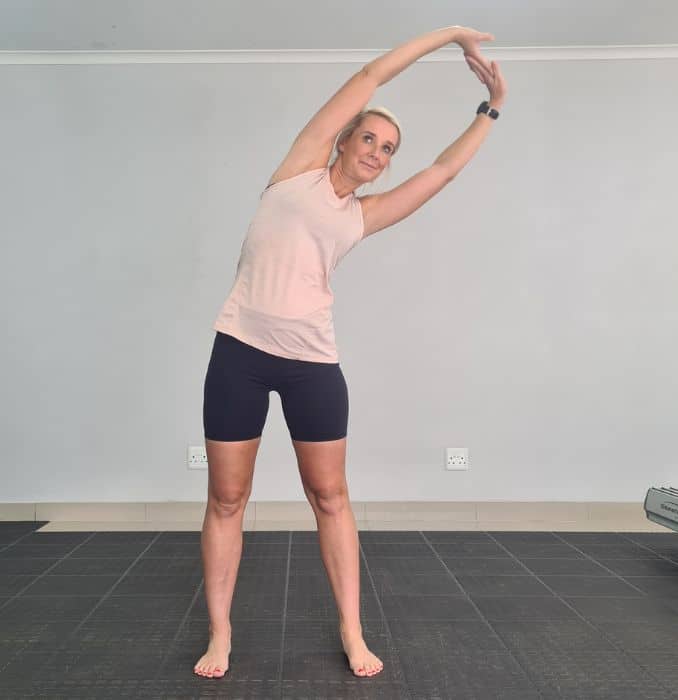
Side Stretch
3. Quad Stretch
Begin in an upright standing position with your feet shoulder-width apart, maintaining good alignment with your head, shoulders, hips, and legs. Engage your core. Bring one heel against your seat, holding your foot with your hand. Hold this position for a couple of seconds. Return to the starting position and repeat the movement on the opposite leg.
If bodyweight balance is a challenge, hold on to the wall or anything stable for support if needed.
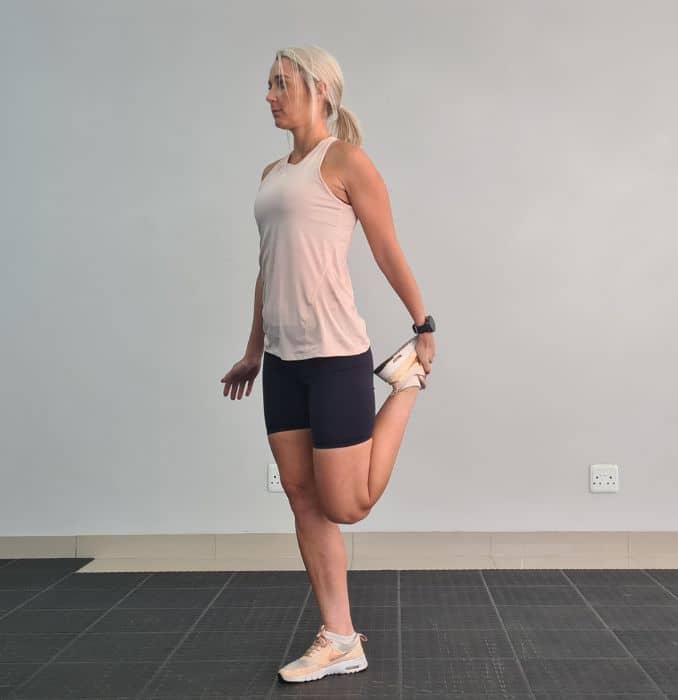
Quad Stretch
The Top Benefits of a Full Body Workout Program
A full-body workout program provides numerous physical and mental health benefits. It helps improve cardiovascular endurance, build muscle mass, and increase overall strength. This occurs by getting your heart rate up and challenging your stamina.
The routine also allows efficient use of time while maximizing the benefits of exercise. It can be done in just one day, making it a convenient option for those with busy schedules. They require only 2–3 sessions per week to see significant results.
Additionally, a full-body workout program can aid in weight loss and body fat reduction, as the high-intensity nature of the training session boosts metabolism and burns more calories than isolated exercises.
Furthermore, full-body workouts can improve balance, mobility, flexibility, and coordination, leading to better joint health and reducing the risk of injury.
Overall, they are versatile and can be modified to suit different fitness levels and goals.
General Guidelines for the Number of Sets Per Muscle Group
The best way to determine the right number of sets per muscle group is to experiment and find what works better for your body and goals.
The number of sets you should perform varies depending on different muscle groups and individual goals. For larger muscle groups, such as the chest muscles, performing 3-5 sets of 8–12 reps is a good starting point. Smaller muscle groups, such as the biceps, may require fewer sets, around 2-3 sets of 8–12 reps.
For those looking to build lean muscle mass, performing 3–4 sets per muscle group with 8–12 reps per set is recommended. This range has been shown to stimulate muscle growth and strength.
Note that the core muscles, which include the abs, obliques, and lower back, should not be neglected. Aim to perform 2-3 sets of core exercises for stability. There is no one-size-fits-all approach to building muscle and paying attention to your core muscles is important, as they provide the foundation for all other movements and can help prevent injury.
Different muscle group requires different amounts of work to see results, and it's important to strike the right balance between intensity and recovery.
Generally speaking, larger muscle groups like the legs and back can handle more sets per workout than smaller ones like the biceps and triceps. However, this may vary based on individual factors such as age, fitness level, and training experience.
Finding the right balance of sets and reps for one muscle group will take time and experimentation, but following these general guidelines can be a great starting point for you to build muscle effectively.
Tips for Achieving Maximum Gains
To achieve maximum gains in your fitness journey, it's important to incorporate the best full-body workout into your routine.
A. Set Goals
Whatever your goal may be, make sure it is achievable so you are more likely to stick with it. When setting your goals, consider your fitness level, training frequency, and desired outcomes.
If you want to burn fat and lose weight, a full-body workout can be a great approach. When it comes to losing weight, setting specific targets is essential. For example, you might set a goal to either lose a certain number of pounds over a certain period or to fit into a specific pair of jeans.
However, it's vital to determine your training frequency based on your fitness level and availability. Again, if you're new to working out, start with smaller goals. Like aiming for 2-3 full-body workouts per week, then gradually increasing to 4-5 as your endurance improves.
Set realistic goals for yourself, such as increasing the number of repetitions or heavier weights lifted each week. It's also important to track your progress and adjust your routine accordingly. You can stay motivated and on track by having a clear plan in place and monitoring your progress.
B. Increase Intensity
Training intensity is crucial in achieving your fitness goals and avoiding injury.
Boost your training intensity by decreasing your rest time between sets. This can elevate your heart rate throughout your workout and help you break through plateaus.
Adding in resistance training and plyometric exercises can challenge your body and gradually increase the intensity of your training. Continuously gaining muscle and pushing yourself to work harder and smarter by increasing the intensity of your training aid in muscle growth and improving strength.
C. Track Progress
When it comes to building muscles and getting in shape, a full-body workout is the best way to get your whole body back in shape. However, it's important to track your progress to ensure that you're working the same muscles consistently and making progress over time.
One effective way to track your progress is by keeping a workout journal or using a fitness app to log your exercises, sets, and reps. This will help you to see your progress over time and identify areas where you may need to switch up your routine or increase the intensity.
Additionally, taking progress photos or measurements can help you see changes in your body composition and celebrate your achievements. You can stay motivated and adjust your body workouts by tracking your progress.
D. Get Enough Rest
Achieving maximum full-body workout gains requires hard work in the gym and proper recovery time.
During training sessions, a rest day is essential for the body to repair and rebuild broken-down muscles. Without proper rest, the body can become tired and prone to injury, thus hindering progress toward fitness goals.
It's important to schedule rest days into your full-body training program and to listen to your body's cues for additional rest when needed. Adequate sleep and proper nutrition also play a crucial role in recovery and maximizing workout gains.
Take at least 1 rest day per week, but the frequency can vary based on your fitness level and workout intensity. So, schedule a rest day and incorporate recovery into your full-body training to see the maximum benefits from your training sessions.
You can reach your fitness goals with a consistent full-body training program and attention to proper form and recovery.
How Many Days Should You Train in a Full Body Workout Program?
When it comes to a full-body workout program, one of the most common questions is how many days a week one should train.
The answer to this depends on several factors, such as fitness level, goals, and recovery time between every training session. A training frequency of 3 to 4 days a week is recommended while allowing a rest day between sessions.
This allows for adequate recovery time and reduces the risk of injury. However, more experienced individuals may benefit from training 5 to 6 days a week with a body part split routine that targets specific muscle groups on different days.
The Benefits of a 3-Day Workout Split
A 3-day full-body workout split has become increasingly popular among fitness enthusiasts due to its various benefits.
By working out 3 times a week, you can get enough exercise to stay healthy and build muscle without overexerting yourself. This type of workout plan allows you to focus on specific muscle groups daily, giving your body the time it needs to recover between workouts.
A 3-day workout split can also help you stay motivated and on track with your fitness goals, providing structure and consistency to your routine. Additionally, this type of workout plan can be customized to your specific fitness level and goals, allowing you to progress comfortably.
Rest Days for Full Body Split
If you're following a full-body part split workout, it can be tempting to push yourself to the limit daily. But taking a rest day is just as important as the workout itself.
Rest day allows your muscles time to recover and regenerate, essential for building strength and endurance.
Depending on your fitness level and the intensity of your full-body workout, having at least 1 or 2 rest days per week is recommended. During this time, focus on low-impact activities such as light stretching, yoga, or gentle walks to promote blood flow and prevent muscle soreness.
Remember, rest days are not a sign of weakness but a crucial component of any successful fitness regimen. Giving your body a break will help you come back stronger and more energized to your next full-body part split workout.
3-Day Full Body Workout Routine Intermediate
A 3-day full-body workout routine is what you need if you're an intermediate-level fitness enthusiast looking for a more challenging body workout routine.
This intermediate-level training program is designed to work for all major muscle groups 3 days a week. It's a combination of compound exercises and isolation movements, which provides a comprehensive workout experience.
With a 3-day full-body workout routine, you can target all your muscles in just 3 workouts a week. This makes a 3-day full-body workout routine a great option for busy individuals who want to maximize their time in the gym.
Therefore, grab your gym bag and get ready to sweat with this 3-day full-body workout routine.
The Association of a 3-Day Full Body Workout Plan and Muscle Growth
A 3-day full-body workout plan can build muscle and transform your physique. This type of workout routine is designed to work for all major muscle groups in your body over the course of 3 days, maximizing your results and helping you achieve your fitness goals.
One of the key benefits of a full-body workout plan is its ability to stimulate muscle growth throughout your body. You can target multiple muscle groups all at once through each workout session, creating a more efficient workout.
When following a 3-day full-body workout plan, it is important to focus on the quality and intensity of your workouts. Incorporate exercises that target all major muscle groups, such as squats, lunges, bench press varieties, rows, and pull-ups.
This 3-day full-body workout plan can be an excellent way to build muscle quickly. So get started on your full-body workout plan today!
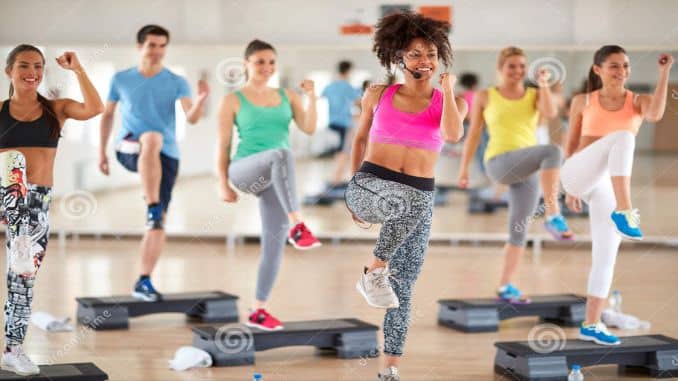
FAQs
How many calories do you burn in a body blast?
Depending on your weight, intensity level, and workout duration, you can burn 300 to 600 calories in a single session.
Body blast exercises typically involve cardio and strength training movements that target multiple muscle groups simultaneously, making them an efficient way to burn calories and improve overall fitness. Additionally, full-body workouts like body blast can help increase your metabolism, which means you continue to burn calories even after exercising.
If you’re looking for a challenging and effective way to burn calories and tone your body, a body blast is a great option.
Is a full-body workout 5 times a week good?
A full-body workout 5 times a week is an excellent way to challenge your muscles and burn calories, as long as you're mindful of your body's needs and limitations.
If you want to get fit and stay healthy, committing to a full-body workout 5 times a week can be an effective strategy. However, giving your muscles enough time to rest and recover between workouts is important.
Overtraining can lead to injury and burnout, so listening to your body and adjusting your workout schedule is crucial.
What is the best full-body workout?
When it comes to finding the best full-body workout, there are plenty of options. That depends on your fitness goals, preferences, and level of fitness. However, some full-body workouts are considered to be more effective than others.
For example, HIIT (High-Intensity Interval Training) is a popular choice because it allows you to burn more calories in less time. Another effective full-body workout is strength training, which involves lifting weights or using resistance bands to build muscle and increase strength. Pilates and yoga are great options for improving flexibility, balance, and overall body conditioning.
The best full-body workout should include exercises that target major muscle groups like the chest, back, legs, and core. Ultimately, the best full-body workout is one you enjoy and can stick to consistently over time.
Is it good to do a full-body workout with weights?
Yes. Adding weights to your full-body workout can further enhance the benefits of increasing resistance and challenging your muscles. However, it is important to approach weightlifting with caution and proper technique to avoid injury.
It's recommended to start with lighter weights and gradually increase as you become more comfortable and confident.
Conclusion: The Benefits of Full Body Workout
The benefits of a full-body blast workout are numerous and can positively impact your overall health and fitness. This full-body training session provides comprehensive and effective full-body workout plans.
One of the biggest advantages of this workout is its ability to torch calories and burn fat quickly. This makes a full-body workout an excellent option for those who want to slim down even with a busy schedule.
In addition to its calorie-burning benefits, this workout can improve your cardiovascular health and reduce your risk of chronic diseases such as heart disease and diabetes. Moreover, this type of workout can also help improve your posture, balance, and coordination, reduce the risk of injury, and improve your overall physical performance.
Incorporating this exercise into your fitness routine can help you achieve a stronger, leaner, healthier body.

